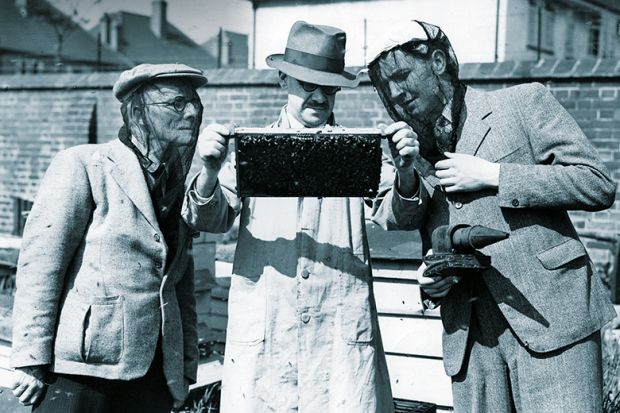Formal training, informal chats with peers over coffee, dropping in on another teacher’s session − these were once all standard ways of discussing and improving teaching practice that have been upended by the coronavirus pandemic and the swift move to online learning.
However, the importance of teaching skills has not lessened, and experts told Times Higher Education that peer observation – in essence, watching another teacher teach – remained a useful tool even in these socially distanced times.
For Susanne Chuku, associate professor of economics at Westfield State University in Massachusetts, “now, more than ever, it’s time to learn from each other, to get constructive feedback, to engage in meaningful discussions about teaching”.
For years, she has organised “open doors” programmes at her university, which allow faculty members to visit their peers’ physical classroom spaces. “While taking on the role of a student, faculty members can participate and experience a different form of pedagogy first hand,” she explained.
The programmes had proved popular, with several faculty members participating in multiple semesters, she said.
The experience left many “inspired and excited”, while others appreciated the opportunity to gain insight into other disciplines, and some valued it as a useful way to receive “low-stakes feedback” on their own teaching, she said.
Through the programmes, seasoned professors learned “new tricks” from younger colleagues, while junior faculty saw how senior faculty interacted with students in their classrooms, Dr Chuku said.
It has also been helpful for breaking down barriers between disciplines, she said. For Dr Chuku, this is “especially relevant in a period of social unrest and instability caused by police brutality and racial injustice. To develop integrated, inclusive and relevant courses across a campus, we must and can learn from visiting classes that address exactly those issues…If you listen, you can learn and afterwards engage in meaningful conversations. You will end up having more tools to address challenging issues in your own classrooms.”
The benefits of the “open door” programmes “greatly outweigh the very low cost”, particularly as “visiting classes online is as easy as it ever will be: you click on a link and you are ‘in’,” she said.
Matt O’Leary, professor of education at Birmingham City University, has written extensively on peer observation, and he agreed that the practice was now as important as ever.
He helped to develop an innovative and collaborative model at his university that focuses on using peer observation “as a tool of enquiry, almost like an ethnographic study of our own classrooms”.
This means ensuring that peer observation is not in any way a form of teaching assessment, but rather an opportunity to discuss teaching and learning, he said. Key principles include pairing up or working in groups, discussing what aspects of teaching the participants want to focus on throughout the observation cycle, preparing a “well-informed and situated action plan” and giving those involved – the observed and the observers – a sense of ownership of the process, he explained.
“We found that people love to talk and share their teaching practices but are rarely given the chance to do so. This gives them that platform,” he said.
The move to online learning has made sitting in on lessons more difficult in one sense, but Professor O’Leary recommended “unseen observation” to get around the problem. While working on a project with lecturers and teachers in further education during the summer, Professor O’Leary found that it was a useful tool that could be easily applied when teaching via Zoom.
Those involved in the project have conversations before the teaching session, discussing what they plan to do in the lesson, what they hope to achieve and what they hope the impact will be. Afterwards, they reflect on how it went.
The chat functions in Zoom and Microsoft Teams, which allow students to pose questions, provide added evidence for the teacher to consider afterwards. At the end of the project, participants write up their reflections, he said.
“It’s exciting; it recalibrates that focus of control that is typically in the hands of the observer,” he said. “Critique doesn’t always help − in fact, it can be detrimental. Peer observation needs to be about bringing about meaningful change, not satisfying an audit.”
Gary Oliver, a senior lecturer at the University of Sydney Business School, agreed that the current teaching situation “provides an opportunity for the curious lecturer to discover techniques, methods and approaches that their colleagues might be using that they might not have thought of and that might not come up in a discussion outside the classroom”.
Dr Oliver was co-author of a 2012 paper in the Journal of University Teaching & Learning Practice on “the benefits of peer observation”, which he said still represented his thoughts on the practice.
“Essentially, the teacher being observed and the observer agree their rules of engagement, so in Covid-19 times it could still occur, but, of course, using Zoom,” he said. And although technology could impose some constraints on what can be observed, the rules of engagement could cover that, he said.
He added that “one of the things that we learned after we published the article, which we didn't realise at the time, was that [peer observation] was so widely applicable to different circumstances, to different disciplines and even to different temperaments of observer and observee”.
Register to continue
Why register?
- Registration is free and only takes a moment
- Once registered, you can read 3 articles a month
- Sign up for our newsletter
Subscribe
Or subscribe for unlimited access to:
- Unlimited access to news, views, insights & reviews
- Digital editions
- Digital access to THE’s university and college rankings analysis
Already registered or a current subscriber? Login








